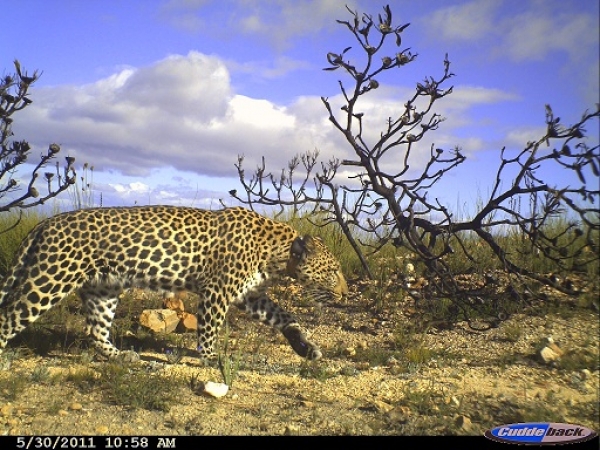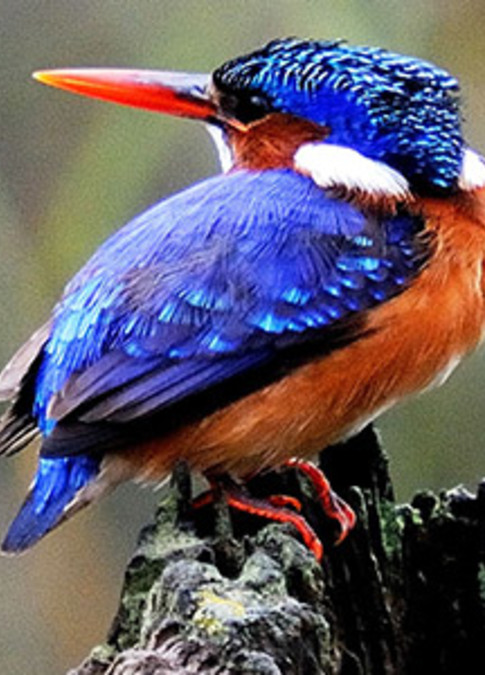Leopards
We were sceptical when first we heard the news: a schoolboy playing near the top of the ridge claimed that he had seen a leopard in the forest fringe, less than two kilometres from an urban area. The other great cat and ‘problem’ animal, the Cape lion, succumbed in the wild a century or more ago, but leopards being opportunistic hunters with nocturnal and secretive habits, have for at least two centuries successfully resisted the best efforts of farmers to eradicate them. So leopards still put in an appearance in the most unlikely places, but nevertheless there seems little doubt that their numbers are dwindling. Was this perhaps one of the lucky survivors?
The local farmers were willing to believe in the presence of the leopard. Although to date none had suffered any stock losses they feared the worst. Nor were their fears allayed when a local taxidermist stated that while he had no doubt that on occasion leopards attacked small stock, in his own experience he had found that the stomach contents of those brought to him usually consisted of dassies*, young buck, guinea-fowl, partidges, jackals, domestic dogs and even rats and mice.
Farmers are realists and over the years they have increasingly come to accept that ridding their farms of leopards does not solve all their problems. In the absence of leopards, jackals or lynx make the most of having the field to themselves. And the absence of leopards often results in a population explosion of dassies . In some areas their numbers increase to such an extent that they move down from the kranses and on to the lands where the sheep graze, adding to the farmer’s problems.

A Cape Leopard in the Rooiberg Mountains, south east of Ladismith. Image courtesy of The Cape Leopard Trust
To protect their stock some farmers resort to the old method of kraaling their sheep at night, but new ways of controlling losses are also tried. Leopards normally make a kill by seizing the throat of their prey, so some farmers fit heavy gauge wire collars to their animals. The use of large, Anatolian dogs to protect the flocks also seems to help. These dogs bond with the sheep and spend their lives with the herd and are quite capable of seeing off a leopard.
Despite those farmers that practice eco-friendly means to protect their animals, and the leopard being declared an endangered species by the Convention on the International Trade in Endangered Species (CITES), scientists believe that there are now fewer leopards in the Eastern Cape than there were 20 or more years ago. One reason for this is that the hunting of leopards has become a profitable business. An animal may be classified as ‘damage-causing’ in which case a permit, specifically targeting a particular individual, is issued. Only South African citizens may use the permit, but a farmer is at liberty to allow another person to do the hunting, cashing in on this by charging hunters R120 000 and more for the opportunity to shoot a leopard.
Is this last great cat going to go the same way as the lion? The more we know of these animals the more likely we are to be able to protect them, so it is good to know that at Kariega Game Reserve and Open Africa’s partner lodges leopard research programmes are in place and operating. There is still hope for these magnificent animals.
Some weeks went by and there was no news of the spotted stalker. Then when Caryl and I were walking in the veld one day we came across what remained of a porcupine lying in a sandy hollow surrounded by bush. Body parts lay scattered over a large area as if the animal had been hit by a ten ton truck. Some of the blood was still sticky indicating that it was not that long dead. We found quills up to 15 meters from the body and by following them and noting the disturbed ground and vegetation it was possible to make out whereabouts the initial encounter had taken place.
Porcupines, with their prickly armour, are treated with circumspection by leopards, but are still considered fair game; the leopard – gingerly - rolling them over to attack them from beneath. To judge by the evidence this particular porcupine had put up a spirited defence. It is not unknown for leopards to come off second best in one of these meetings, and there have even been instances of leopards dying when the wounds inflicted by the quills turned septic.
We have neither heard nor seen any more of the leopard since then and hope that it has gone on to enjoy rather more convenient meals of dassie and guinea-fowl – and for everyone’s sake, no sheep or goats.
*Dassie = hyrax.










